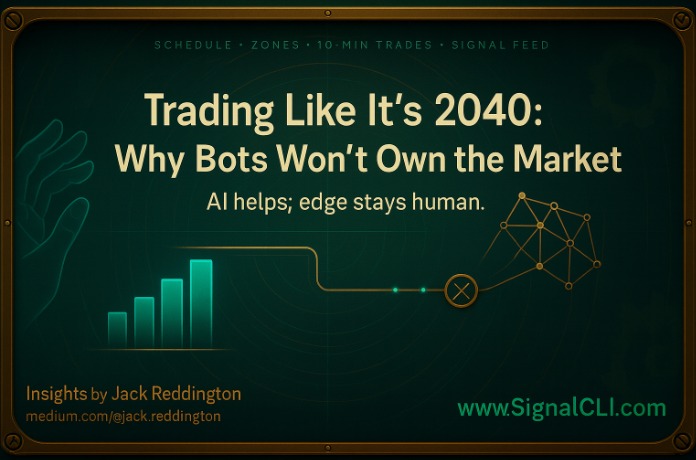Let’s start with the heresy: AI is not about to wake up tomorrow, shrug, and replace every trader. Not in five, ten, even fifteen years either. The “fully autonomous, always-profitable super-bot” is a nice bedtime story — right up there with “gas fees will be free”. Today’s reality is simpler and more annoying: current autonomous bots are just overconfident spreadsheets with Wi‑Fi.
Yes, we’ve moved a long way from the era when trading tools were locked inside banks and whispered about like dark arts. In 2025, AI-assisted trading is broadly accessible. You can rent a model, wire up a data feed, and drown in optimization settings before lunch. You can follow daily schedules, honor Green–Yellow–Red zones, and take your 10-minute trades from a mature crypto futures signals platform. The tech pushed us forward. But the winning setup still looks suspiciously human: a disciplined person on top of smart software — not the other way around.
Disclaimer: When quantum computers finally turn the corner, sure — it’ll be a different story.
But first, we’ll have to wade through the security drama (let’s be honest: much of today’s cybersecurity rests on “it’ll take billions of years for current machines to crack that password”. Keyword: current).
Second, the most likely early, practical beneficiaries of “break‑almost‑anything” compute will be government outfits.
Third — and only if that second point happens — they’ll become the strongest lobby against broad release; it’s extremely lucrative to keep that capability up your sleeve during hard‑nosed negotiations with another country’s leadership. But relax: this isn’t a conspiracy piece; it’s just incentives 101.
“If a bot can win, doesn’t trading… disappear?”
Let’s poke the paradox. If someone builds the first truly independent, consistently profitable bot — no oversight, no human babysitting — does that mean trading is over? Who loses so we can all win? Markets are not Christmas; money doesn’t materialize from thin air. In most regimes, it moves from Point A to Point B and back, plus some growth from new participants and macro tailwinds.
If everyone runs the same profitable bot, profit disappears. Edge is a relative thing. Once it’s crowded, it’s compost. The only way an always-winning bot survives is if it a) adapts faster than everyone else (which means it’s still human-directed somewhere), or b) enjoys an unfair advantage (private data, co-location, policy influence—which, to be clear, is not an “AI” story; it’s an access story).
In other words: the first bot that reliably mints cash would collapse its own edge by being copied. No edge, no magic. Markets breathe; they don’t hand out lifetime memberships.
Why the “AI will decide for you” timeline is fantasy (for now)
Here’s the boring truth: today’s AI trading pipelines still struggle with three things that humans do well:
- Ambiguity. Models love yesterday’s data; they’re allergic to “this looks weird.”
- Regime shifts. Great at trend A, confused by trend B; spends a month “relearning” while your P&L journals its feelings.
- Context. News, leadership changes, regulatory rumor, social mood — all the human texture that moves tape right when your bot is busy being “objective”.
Until quantum computing exits the conference keynote and lands on your desktop, the “AI runs the whole show” forecast is generous fan fiction. Even then, the issue won’t be computation alone; it’ll be the same old bottleneck: edge diffusion. The faster everyone’s compute gets, the faster everyone copies everyone else. Differential advantage shrinks, not expands.
So what actually changes?
Access. That’s the big win. What used to live inside banks is now on laptops. Structured AI-assisted signals you can trust for short-term trades exist. You can work with daily schedules, lean on performance-graded zones, and scan a high volume of signals per day without chaining yourself to a chair. This is where a proper provider earns its keep: not in pretending it’s magic, but in giving you a clean map and a repeatable tempo.
The secret sauce isn’t that the tech is perfect. It’s that your routine is. The difference between noise and process is a 10-minute trade that’s part of a schedule versus a 10-minute panic that’s part of a binge.
Humans still win the weird stuff
Markets move on math, sure. They also move on people. CEOs get fired or hired. A fund blows up. A rumor lands. A policy line in a press release gets misread, memed, then repriced. Your bot can parse words; it still can’t smell panic. You can.
This is why I keep arguing that the best stack is human-over-AI. Let the software do what it does best: scan, filter, quantify, suggest. You do what you do best: set context, decide when not to play, and, yes, follow your schedule instead of your adrenaline. If you treat AI as “autopilot,” don’t be shocked when it follows you into a cloud at 300 knots.
“But won’t smarter bots fix all that?”
They’ll get better at mechanics — fills, routing, micro-timing. They’ll do cleverer risk management. They’ll read tone better. Great. That still doesn’t solve the edge paradox. If the same models graduate from the same MOOCs, pull the same datasets, and optimize on the same leaderboards, their decisions converge. Converged behavior kills advantage. Suddenly everyone’s “smart,” and the tape is back to being mean.
In that world, the new alpha is old: discipline. Who trades the Green windows and sits out the Red. Who accepts fewer, cleaner decisions. Who uses a signals feed the way a pilot uses instruments — not to feel brave, but to stay right‑side up.
What bots actually break (and what they don’t)
Bots — especially the “fire-and-forget” kind — break humans before they break markets. They encourage detachment (“the system has it”), which fast-forwards you to the worst part: you stop learning. And when a bot stumbles — and it will — you don’t have the mental furniture to spot why. You get the loss and none of the lesson.
What bots won’t break is the fundamental sociology of trading: the constant negotiation between fear, greed, and information. As long as humans have jobs, bills, ambitions, timelines, and sleep cycles, there will be mispricings. Your job is not to banish mistakes — it’s to design a life where mistakes don’t sink you.
A saner doctrine (aka why this isn’t doom)
Use AI-assisted tools because they reduce friction, not because they promise miracles. Show up for the daily schedule. Treat zones as a traffic light system instead of a dare. Take the 10-minute opportunities that fit your day and your temperament. Let the signal feed do the heavy lifting so your attention can do the heavy thinking.
If some mythical, universally profitable bot appears tomorrow, the market won’t die; it’ll mutate, like it always does. Fees will shift. Latencies will matter again. Venues will add frictions, then sell you the antidotes. The edge will move somewhere slightly more annoying. It always does.
Until then, keep the hierarchy intact: you first, tools second. That’s not anti-tech; it’s pro-survival. The smartest trade you can make in an automated world is the one where you still know why you placed it.
Closing thought
Treat AI like you treat a car, a hammer, a piece of furniture. It has a purpose; it’s very good at its purpose; use it for that purpose. Funny enough, that’s the same reason why (with today’s tech) a one‑person, billion‑dollar company isn’t popping up out of nowhere: AI needs a human. For the billion‑dollar scale, make it plural — humans. There are only 24 hours in a day, and as a single person you can fix only so many mistakes an AI produces in a heartbeat. As a group, combined, the pair becomes powerful; but the AI still needs people to get great results (and there are a lot of limitations to that statement too. You can read more here). Its limits are defined by the human steering it. Human‑in‑the‑loop isn’t optional; it’s the point.
Keep the structure. Keep the schedule. Use the feed. Take the Green when it’s there, pass on the Red when it screams. Let the bot do the boring bits. And let your brain do the thing that never goes out of style: deciding.
About SignalCLI
SignalCLI is a crypto futures signals provider focused on clarity, precision, and informed decision-making. Using a combination of established technical indicators, Smart Money Concepts, and advanced AI analysis, SignalCLI delivers structured, data-driven insights to help traders identify high-probability setups in fast-moving markets. The service is designed for those who value disciplined execution, risk awareness, and timing over speculation. For deeper insights and practical examples, visit www.signalcli.com and explore Jack Reddington’s Medium for trading strategies, market breakdowns, and educational articles.



